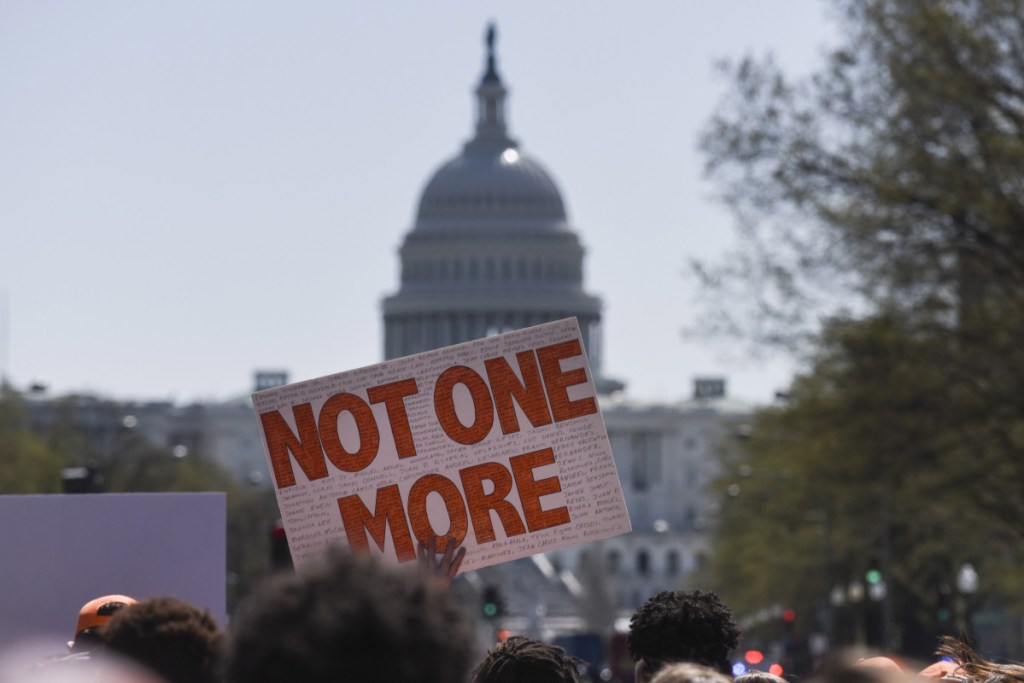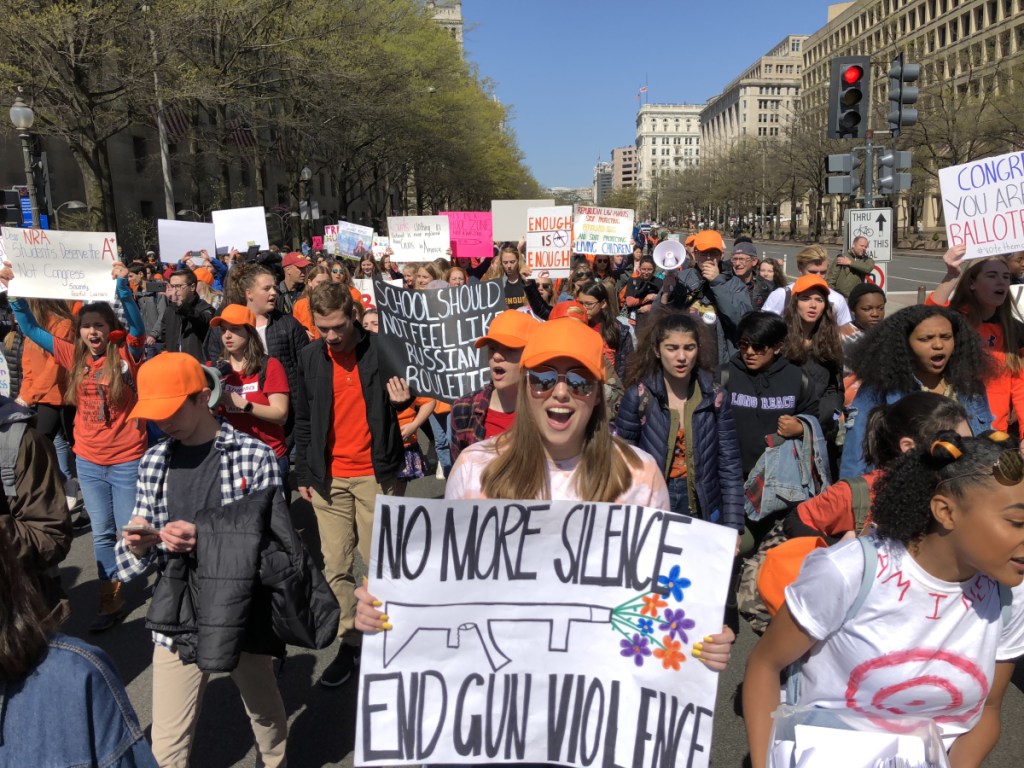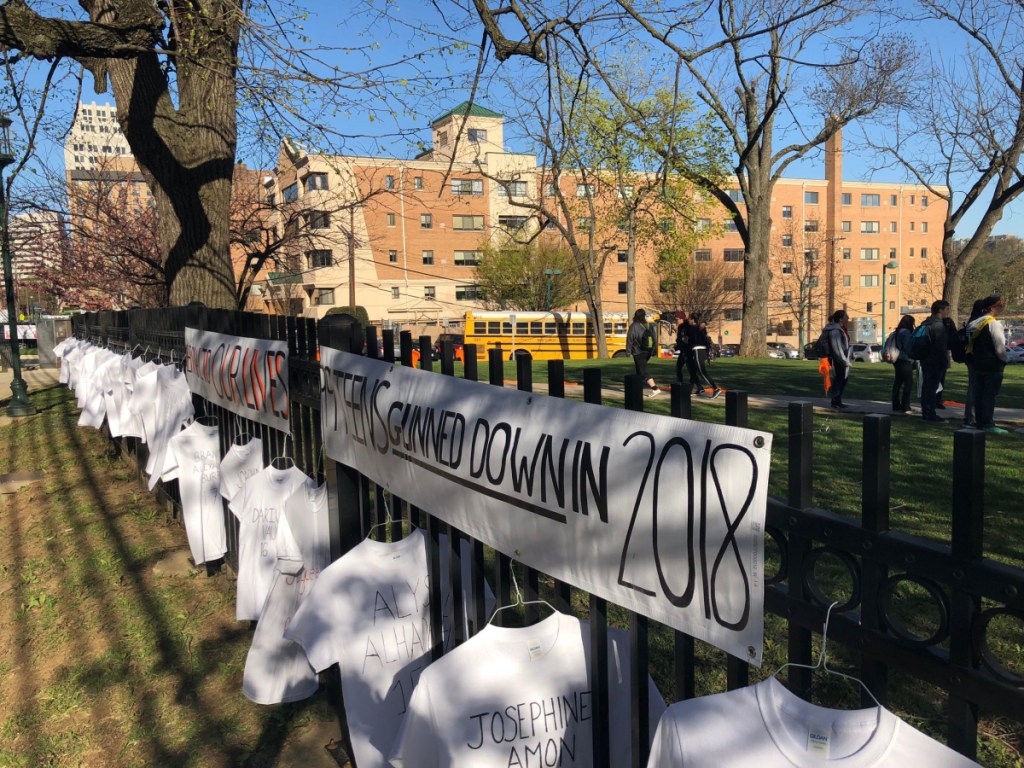Students calling for an end to gun violence walked out of school Friday, the 19th anniversary of the school shooting in Columbine, Colorado, an event that marked the start of an era of deadly school rampages.
The walkouts Friday were sparked by Lane Murdock, a 16-year-old at Ridgefield High School in Connecticut, who began an online petition calling for the protest after the February shooting in Parkland, Florida, that left 14 students and three staff members dead. Walkouts were planned at more than 2,000 schools nationally, Murdock said.
But the scale and scope of the protests appeared to be much smaller than a similar student-led national walkout on March 14 and the “March for Our Lives” rallies in Washington and cities and towns across the country on March 24.
A number of factors may have contributed to the lower turnout, including a lack of promotion and questions about its goals, conflicts with mandatory standardized testing, and, in some cases, protest fatigue among students.
School administrators were also rethinking their approach to the student actions. In many school districts that had encouraged or even facilitated student participation in earlier walkouts or moments of silence on campus, administrators were less inclined to continue accommodating the protests.
At Marjory Stoneman Douglas High School in Parkland, the site of the February massacre, about 100 students walked out of class and went to a nearby park to sign a large poster in support of the Columbine students. But the vast majority of the school’s 3,100 students remained on campus.
Students at a Forest High School in Ocala, Florida, 270 miles north of Parkland, had to cancel their planned walkout after an early morning shooting at their school. One student was injured and the shooter, a former student, was taken into custody.
In the Washington region, several hundred students left their schools Friday morning and staged a vigil outside the White House to honor the Columbine victims and others killed by gun violence.
Aniyah Smith, 17, knew not everyone in her community could make it into Washington to attend another school walkout.
So, she had an idea: Collect letters from her classmates, teachers, community.
On Friday, Smith arrived from Arlington, Virginia, with hundreds of letters, packed into plastic bins and bags.
“We’ve marched and we’ve been ignored. We walked out and we’ve been ignored. Let’s see (legislators) try to ignore us when we drop these right outside your office door,” said Smith, a senior at Wakefield High School. “Letters are powerful. You can’t ignore what someone is saying when it’s in writing.”
Smith said she was inspired by the March 14 walkouts, and watching her peers become more involved in the March for Our Lives event March 24.
“I just always assumed someone else would do something about things that are wrong in the world, you know?” Smith said. “But then I realized, why don’t I do it? Why can’t that someone be me? So, I did.”
As hundreds of students sat in silence for 19 minutes – one for every year since the Columbine shooting – Smith filled the silence by reading the names of the victims over a megaphone.
“We stopped saying their names a long time ago,” she said. “So until the end of this moment of silence, I will continue to repeat their names so you guys don’t forget them.”
The students then marched to the Capitol for a rally and to deliver letters to lawmakers calling for tougher gun-control measures.
Hannah Weisman, 18, a senior at Walt Whitman High School in Bethesda, Maryland, was among the first Washington-area students to arrive Friday morning along with her friends Piper Deleon, 17, and Zoe Tompkins, 17, both Walt Whitman seniors.
Though the three Whitman students said they expected Friday’s march to be smaller than the March 14 walkouts – in which hundreds of students marched in protest from the White House to the Capitol following 17 minutes of silence in honor of the 17 people killed in the February school shooting in Parkland – they hoped their message would still be heard.
All three were born a year or more after the attack at Columbine High School.
“It’s scary because that was so long ago, and we’re here because nothing’s changed,” Deleon said. “I hope that us speaking up, the young people speaking up, will get everyone else to speak up.”
Weisman said that since the Parkland shooting on Feb. 14, she has been wondering if her school could be next.
“It’s really upped my paranoia,” she said. “We’ve gotten bomb threats, we do these active-shooter drills. But it just feels so much more real now. It could happen here.”
The girls opted to forgo signs this time because they felt the mood was more somber than last month’s walkouts, which they described as a protest. On Friday, they were present to honor the slain.
As with a 17-minute walkout that unfolded on March 14, school districts have tried to strike a balance between giving students space to exercise free speech and not disrupting learning or risking safety.
Send questions/comments to the editors.





Success. Please wait for the page to reload. If the page does not reload within 5 seconds, please refresh the page.
Enter your email and password to access comments.
Hi, to comment on stories you must . This profile is in addition to your subscription and website login.
Already have a commenting profile? .
Invalid username/password.
Please check your email to confirm and complete your registration.
Only subscribers are eligible to post comments. Please subscribe or login first for digital access. Here’s why.
Use the form below to reset your password. When you've submitted your account email, we will send an email with a reset code.